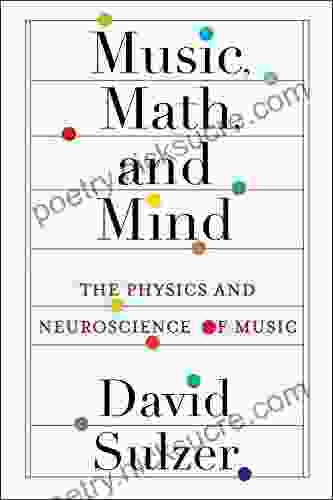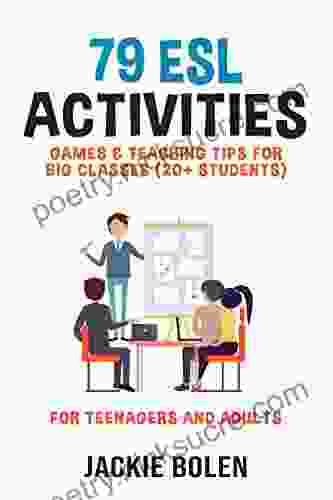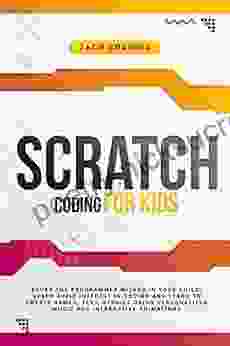Music, Math and Mind: Exploring the Interconnections

4.2 out of 5
| Language | : | English |
| File size | : | 34044 KB |
| Text-to-Speech | : | Enabled |
| Screen Reader | : | Supported |
| Enhanced typesetting | : | Enabled |
| Word Wise | : | Enabled |
| Print length | : | 294 pages |
Music, math and mind are three seemingly disparate disciplines that, when examined closely, reveal a fascinating web of interconnections. Throughout history, scholars and artists have recognized the profound relationship between these fields, with many believing that music and math share a universal language that transcends cultural and linguistic barriers. In this article, we will explore the multifaceted connections between music, math and mind, uncovering the ways in which they shape our perception, cognition and creativity.
The Rhythmic Mind
One of the most striking connections between music and math lies in the realm of rhythm. Rhythm is a fundamental element of both music and mathematics, and it plays a vital role in our perception of time and motion. The ability to perceive, produce and synchronize with rhythmic patterns is a complex cognitive skill that involves multiple brain regions, including the basal ganglia, cerebellum and auditory cortex.
Studies have shown that musical training can enhance rhythm processing abilities, improving timing accuracy and beat perception. This suggests that music and math share common neural mechanisms that support the processing of rhythmic information. Moreover, rhythmic patterns in music can influence our perception of time, making it appear to speed up or slow down depending on the tempo and beat structure.
The Harmonic Brain
Harmony, another essential element of music, also has deep connections with mathematics. In Western music theory, harmony is based on the mathematical relationships between different notes and chords. These relationships are governed by principles of consonance and dissonance, which create a sense of balance and tension within a musical composition.
When we listen to music, our brains process these harmonic relationships and respond with emotional and physiological changes. Consonant harmonies tend to evoke feelings of pleasure and relaxation, while dissonant harmonies can create tension and excitement. This suggests that music can directly affect our emotional state through its mathematical structure.
The Mathematical Mind
Beyond its rhythmic and harmonic dimensions, music also shares a deep connection with mathematics in its mathematical structure. The beauty of music often lies in its mathematical elegance, with patterns, symmetries and proportions creating a sense of order and coherence.
For example, the Fibonacci sequence, a series of numbers where each number is the sum of the two preceding ones (1, 1, 2, 3, 5, 8, 13, ...),is frequently found in musical compositions. This sequence creates a sense of balance and harmony, and it can be heard in the melodies of many popular songs.
Music and the Developing Mind
The interconnections between music, math and mind are evident not only in adult brains but also in the developing brains of children. Music education has been shown to have numerous benefits for cognitive development, including improved language skills, enhanced memory and increased spatial reasoning abilities.
Research suggests that musical training can strengthen neural connections in the brain, particularly in areas responsible for language, math and executive function. This suggests that music can act as a catalyst for cognitive development, fostering the growth of essential brain structures and functions.
The interconnections between music, math and mind are vast and profound. From the rhythmic patterns that synchronize our minds to the harmonic structures that evoke emotions, music and math share a deep and fundamental connection. Understanding these interconnections not only enriches our appreciation of both disciplines but also provides valuable insights into the workings of the human mind. As we continue to explore the interconnections between music, math and mind, we will undoubtedly uncover even more fascinating and transformative connections that shape our perception, cognition and creativity.
4.2 out of 5
| Language | : | English |
| File size | : | 34044 KB |
| Text-to-Speech | : | Enabled |
| Screen Reader | : | Supported |
| Enhanced typesetting | : | Enabled |
| Word Wise | : | Enabled |
| Print length | : | 294 pages |
Do you want to contribute by writing guest posts on this blog?
Please contact us and send us a resume of previous articles that you have written.
 Fiction
Fiction Non Fiction
Non Fiction Romance
Romance Mystery
Mystery Thriller
Thriller SciFi
SciFi Fantasy
Fantasy Horror
Horror Biography
Biography Selfhelp
Selfhelp Business
Business History
History Classics
Classics Poetry
Poetry Childrens
Childrens Young Adult
Young Adult Educational
Educational Cooking
Cooking Travel
Travel Lifestyle
Lifestyle Spirituality
Spirituality Health
Health Fitness
Fitness Technology
Technology Science
Science Arts
Arts Crafts
Crafts DIY
DIY Gardening
Gardening Petcare
Petcare Silvia M Lindtner
Silvia M Lindtner Jill Lepore
Jill Lepore Joey Myers
Joey Myers Anna B Doe
Anna B Doe Louise Katz
Louise Katz J Scott Long
J Scott Long Annalyn Ng
Annalyn Ng Barbara Sealock
Barbara Sealock Gwen Mckee
Gwen Mckee John Yates
John Yates Annaka Harris
Annaka Harris Chase Hassen
Chase Hassen Ian Moulding
Ian Moulding Anna Bright
Anna Bright Robby Weber
Robby Weber Caryl Phillips
Caryl Phillips Holly Bourne
Holly Bourne Steve Bennett
Steve Bennett Skeleton Steve
Skeleton Steve Joe Hyams
Joe Hyams Steven Yellin
Steven Yellin E R Truitt
E R Truitt Roy R Grinker
Roy R Grinker Pawel Malczewski
Pawel Malczewski Jay Young
Jay Young Finn Aagaard
Finn Aagaard Anna Lowenhaupt Tsing
Anna Lowenhaupt Tsing Kass Morgan
Kass Morgan Tony Osgood
Tony Osgood Matthew Rudy
Matthew Rudy Valerie Hansen
Valerie Hansen Henry Dillon
Henry Dillon Harold Davis
Harold Davis Paul Bloom
Paul Bloom Timothy P Schultz
Timothy P Schultz Matthew Locricchio
Matthew Locricchio Steve Grant
Steve Grant Stephen J Pyne
Stephen J Pyne Barak A Bassman
Barak A Bassman Horace Kephart
Horace Kephart James P Sethna
James P Sethna Laurie Varga
Laurie Varga Christopher T Coughlin
Christopher T Coughlin Helge Kragh
Helge Kragh Lisa Manterfield
Lisa Manterfield Sparknotes
Sparknotes Asker Jeukendrup
Asker Jeukendrup Linda K Miller
Linda K Miller Steven Munatones
Steven Munatones Charlene Beswick
Charlene Beswick Stan Gibilisco
Stan Gibilisco Bethany Saltman
Bethany Saltman Heidi Kreider
Heidi Kreider Gemma Bray
Gemma Bray Julie A Ross
Julie A Ross Peter Watson
Peter Watson Reinhard Kleist
Reinhard Kleist Sandy Bodeau
Sandy Bodeau Stephen Tarsitano
Stephen Tarsitano Kristina Cowan
Kristina Cowan John Dunn
John Dunn Ling Seto
Ling Seto Sukhveer Singh
Sukhveer Singh James C Scott
James C Scott Melvin Fitting
Melvin Fitting Nicholas Thomas
Nicholas Thomas Jay Allan
Jay Allan Danny Jones
Danny Jones Graham Robb
Graham Robb Dave Hall
Dave Hall Zach Hunter
Zach Hunter Trevor Hartman
Trevor Hartman Steve Oldenburg
Steve Oldenburg Antonio Robert
Antonio Robert Zoe Moore
Zoe Moore Richard A Ruth
Richard A Ruth Stephanie Cave
Stephanie Cave Anna Watson
Anna Watson L Chapman
L Chapman Monroe Wildrose
Monroe Wildrose Stacey Williams
Stacey Williams Randy J Paterson
Randy J Paterson Ralph Cockburn
Ralph Cockburn Neel Doshi
Neel Doshi Christine Hopfgarten
Christine Hopfgarten Sara Dyer
Sara Dyer Jenn Bennett
Jenn Bennett Paulo Guillobel
Paulo Guillobel Tarani Chandola
Tarani Chandola Sally Black
Sally Black Joy Dawson
Joy Dawson Linda Lewis Alexander
Linda Lewis Alexander Dave Hughes
Dave Hughes Steven G Krantz
Steven G Krantz Hope Comerford
Hope Comerford Craig Ramsay
Craig Ramsay Dean Buonomano
Dean Buonomano Kalman Samuels
Kalman Samuels Anna Flores Locke
Anna Flores Locke Patricia Romanowski Bashe
Patricia Romanowski Bashe Jonathan Pd Buckley
Jonathan Pd Buckley Richard A Swanson
Richard A Swanson Jennifer L Lopez
Jennifer L Lopez Marie Cirano
Marie Cirano Chris Gore
Chris Gore P M Gilbert
P M Gilbert Ann Marie Brown
Ann Marie Brown Margaret Paul
Margaret Paul Michael Burnett
Michael Burnett Roy M Wallack
Roy M Wallack Patrick Torsell
Patrick Torsell Stefan Hollos
Stefan Hollos Charles Dickens
Charles Dickens Annabel Streets
Annabel Streets Eddie Jones
Eddie Jones James C Zimring
James C Zimring Hanumant Deshmukh
Hanumant Deshmukh Kyung Won Chung
Kyung Won Chung Zena Hitz
Zena Hitz Sean Bartram
Sean Bartram Victor Stringer
Victor Stringer Richard Mcafee
Richard Mcafee Junior Health Institute
Junior Health Institute Frances Schultz
Frances Schultz Eric Greitens
Eric Greitens Noel D Justice
Noel D Justice Justine Gregory Williams
Justine Gregory Williams Jay Spence
Jay Spence Oskar Morgenstern
Oskar Morgenstern College Hippo
College Hippo Helen Adrienne
Helen Adrienne Emily J Taylor
Emily J Taylor Aaron Mahnke
Aaron Mahnke Ben Shneiderman
Ben Shneiderman Stefanie Japel
Stefanie Japel Elizabeth Wissner Gross
Elizabeth Wissner Gross Nancy Marie White
Nancy Marie White Lina Beard
Lina Beard C W Farnsworth
C W Farnsworth Robin Esrock
Robin Esrock Sean Purchase
Sean Purchase Anna Crowley Redding
Anna Crowley Redding Ellen Dugan
Ellen Dugan Genevieve Mckay
Genevieve Mckay Anna Quindlen
Anna Quindlen Louis Van Dyke
Louis Van Dyke Jenna Evans Welch
Jenna Evans Welch Lori L Tharps
Lori L Tharps Kristian Berg
Kristian Berg Sally Connolly
Sally Connolly Ray Eye
Ray Eye Brian Daccord
Brian Daccord Livia Bitton Jackson
Livia Bitton Jackson Gary Chapman
Gary Chapman Arcturus Publishing
Arcturus Publishing Steve Newell
Steve Newell Mishka Shubaly
Mishka Shubaly Patricia Ladis
Patricia Ladis Peter Hathaway Capstick
Peter Hathaway Capstick Melanie Dickerson
Melanie Dickerson Dave Whitlock
Dave Whitlock Ann Voskamp
Ann Voskamp Kristen L Mauk
Kristen L Mauk Fumio Sasaki
Fumio Sasaki Kate Mcvaugh
Kate Mcvaugh Sherry B Ortner
Sherry B Ortner Shelley Emling
Shelley Emling Jacob Ward
Jacob Ward Chris Fregly
Chris Fregly Stuart Tomlinson
Stuart Tomlinson Howard Means
Howard Means Helen E Lees
Helen E Lees Matthew Cobb
Matthew Cobb Christelle Dabos
Christelle Dabos Bren Smith
Bren Smith George James Grinnell
George James Grinnell John Van Wyhe
John Van Wyhe Creative Guy
Creative Guy Eleanor J Sullivan
Eleanor J Sullivan Buddy Lee
Buddy Lee Michael Witwer
Michael Witwer Suzanne Girard Eberle
Suzanne Girard Eberle Daphne Poltz
Daphne Poltz Will Kurt
Will Kurt Tara Haelle
Tara Haelle Darryl Belfry
Darryl Belfry Todd Radom
Todd Radom Jackson Carter
Jackson Carter Geryn Childress
Geryn Childress Jonathan R Brennan
Jonathan R Brennan R A Salvatore
R A Salvatore H Jerome Chapman
H Jerome Chapman Richard C Schwartz
Richard C Schwartz Anna Ivey
Anna Ivey Julian Havil
Julian Havil Rutger Bregman
Rutger Bregman Ariel Dalfen
Ariel Dalfen Joshua Shifrin
Joshua Shifrin L J Smith
L J Smith Nicholas Clapp
Nicholas Clapp Michael F Nenes
Michael F Nenes David Berry
David Berry Roger Hall
Roger Hall Michael Hodgson
Michael Hodgson J E Esslemont
J E Esslemont John O Sullivan
John O Sullivan Katharine Beals
Katharine Beals Julian Of Norwich
Julian Of Norwich H M Schey
H M Schey L J Martin
L J Martin Rebecca A Moyes
Rebecca A Moyes Peter L Falkingham
Peter L Falkingham Bob Cary
Bob Cary Mark Mckinney
Mark Mckinney M Terese Verklan
M Terese Verklan Todd Denault
Todd Denault Julie C Meloni
Julie C Meloni Suzanne Clark
Suzanne Clark Chic Scott
Chic Scott Clive Scarff
Clive Scarff Jack Perconte
Jack Perconte Ray Moynihan
Ray Moynihan Daniel Isberner
Daniel Isberner Mikael Lindnord
Mikael Lindnord Jonathan Franklin
Jonathan Franklin Good Books
Good Books Michael Tan
Michael Tan Jason
Jason John Edwards
John Edwards Dorothy Ours
Dorothy Ours Robert A Conover
Robert A Conover Joanna Wells
Joanna Wells Barb Musick
Barb Musick Hannah Testa
Hannah Testa Chronicle Books
Chronicle Books William Goldman
William Goldman Naomi Tomky
Naomi Tomky Robert Gerver
Robert Gerver Katie Krimer Ma Lcsw
Katie Krimer Ma Lcsw Julie Creffield
Julie Creffield Jennifer Dugan
Jennifer Dugan Joyce Meyer
Joyce Meyer Rebecca Carroll
Rebecca Carroll Larry Thornberry
Larry Thornberry Quinn Loftis
Quinn Loftis Philip Reed
Philip Reed Morton Manus
Morton Manus Ann Zaprazny
Ann Zaprazny Larry Semento
Larry Semento Anne Sylvie Malbrancke
Anne Sylvie Malbrancke Rick Sparkman
Rick Sparkman Adil E Shamoo
Adil E Shamoo Bernard Stiegler
Bernard Stiegler Zach Davis
Zach Davis Susan Spicer
Susan Spicer L A Cotton
L A Cotton Guy Windsor
Guy Windsor Nelson Dellis
Nelson Dellis John Dickson
John Dickson Dr Harper
Dr Harper John Baichtal
John Baichtal Susan M Schneider
Susan M Schneider Prime Hall
Prime Hall Peter Richmond
Peter Richmond Becky Wade
Becky Wade Bob Labbe
Bob Labbe Sarah Stodola
Sarah Stodola Timothy Ellis
Timothy Ellis Boye Lafayette De Mente
Boye Lafayette De Mente Sally Annjanece Stevens
Sally Annjanece Stevens Dannah Gresh
Dannah Gresh Suzanne I Barchers
Suzanne I Barchers Krista Marson
Krista Marson Lane Demas
Lane Demas Frank Thomas
Frank Thomas Dan Gardner
Dan Gardner Wendy Leo Smith
Wendy Leo Smith Crystal Cook
Crystal Cook Steve Olson
Steve Olson Sam Demas
Sam Demas Melissa Mortenson
Melissa Mortenson Fox Fisher
Fox Fisher Richard Appleton
Richard Appleton Jenny Jacobs
Jenny Jacobs Robert F Boszhardt
Robert F Boszhardt Gloria Chadwick
Gloria Chadwick Bob Madgic
Bob Madgic Kendall Coyne
Kendall Coyne Sandy Camillo
Sandy Camillo William P Young
William P Young Anna Grafl
Anna Grafl Martin Meredith
Martin Meredith Marva Boatman
Marva Boatman Gilbert J Grant Md
Gilbert J Grant Md Christine Field
Christine Field Steven Callahan
Steven Callahan Carl Mckeating
Carl Mckeating Winton Porter
Winton Porter Annette Burns
Annette Burns Martin N Seif
Martin N Seif John Pullen
John Pullen Dan Vogel
Dan Vogel John Murray
John Murray Jennifer Kostick
Jennifer Kostick Maggie Downs
Maggie Downs June Hur
June Hur Damian Hall
Damian Hall Steve Schwartz
Steve Schwartz Ann Valett
Ann Valett R K Agarwal
R K Agarwal Lily Siou
Lily Siou Susan Straub
Susan Straub Josephine Mccarthy
Josephine Mccarthy Lizzie Collingham
Lizzie Collingham Emmett W Hines
Emmett W Hines Janine Marsh
Janine Marsh Miley Smiley
Miley Smiley Ken Robinson
Ken Robinson Alexander L Chapman
Alexander L Chapman George Lakoff
George Lakoff Dante Fortson
Dante Fortson Ford R Bryan
Ford R Bryan Tanmay Mehta
Tanmay Mehta Mordecai Orimiladeye
Mordecai Orimiladeye Illysa R Foster
Illysa R Foster Harley Mcallister
Harley Mcallister Pradeepa Narayanaswamy
Pradeepa Narayanaswamy Jackie Bolen
Jackie Bolen Gill James
Gill James Ruby Mcconnell
Ruby Mcconnell Julia Galef
Julia Galef Peyton Curley
Peyton Curley Horace Freeland Judson
Horace Freeland Judson Worley Faver
Worley Faver Seth Stephens Davidowitz
Seth Stephens Davidowitz Illustrated Edition Kindle Edition
Illustrated Edition Kindle Edition Alex Bromley
Alex Bromley Pierluigi Barrotta
Pierluigi Barrotta Dr Sarita Uhr
Dr Sarita Uhr Michael G Manning
Michael G Manning Donna D Ignatavicius
Donna D Ignatavicius Jeff Kuehl
Jeff Kuehl Shawn Shallow
Shawn Shallow Peter Wacht
Peter Wacht Karen Bassie Sweet
Karen Bassie Sweet Margaret Jean Langstaff
Margaret Jean Langstaff Bert Mendelson
Bert Mendelson Paul Logothetis
Paul Logothetis Mike Roberts
Mike Roberts Jean Barbre
Jean Barbre Walter Mischel
Walter Mischel Glen E Clarke
Glen E Clarke Breeda Bermingham
Breeda Bermingham Steve Bowkett
Steve Bowkett Ann Mccallum Staats
Ann Mccallum Staats Judy Corry
Judy Corry Sean Covey
Sean Covey Cathy Glass
Cathy Glass Wayne C Booth
Wayne C Booth Philip Gibson
Philip Gibson Scott Allan
Scott Allan Maya Van Wagenen
Maya Van Wagenen Anna Della Subin
Anna Della Subin James Burke
James Burke Freddy Silva
Freddy Silva Sharon Rowley
Sharon Rowley Anna Wood
Anna Wood Lisa Randall
Lisa Randall Curtis Collins
Curtis Collins Charles J Sanders
Charles J Sanders Mike Reilly
Mike Reilly James F Twyman
James F Twyman Bella Forrest
Bella Forrest Bruce Lockwood
Bruce Lockwood Barry Dainton
Barry Dainton Christina Henry De Tessan
Christina Henry De Tessan Sheela Raja
Sheela Raja Lexi Ryan
Lexi Ryan Marjorie Savage
Marjorie Savage Dana James
Dana James Vittal S Anantatmula
Vittal S Anantatmula W W Sawyer
W W Sawyer Randall Fitzgerald
Randall Fitzgerald Johnny Chuong
Johnny Chuong Angela Saini
Angela Saini Margaret Rogerson
Margaret Rogerson Harnarayan Singh
Harnarayan Singh Adele Faber
Adele Faber Darcie Little Badger
Darcie Little Badger Barry Schwartz
Barry Schwartz Neal Shusterman
Neal Shusterman Jemar Tisby
Jemar Tisby Scott Shupe
Scott Shupe Sharman Apt Russell
Sharman Apt Russell David Woods
David Woods Les Livingstone
Les Livingstone Vladimir Vasiliev
Vladimir Vasiliev Omari Bouknight
Omari Bouknight Steven A Fino
Steven A Fino Caroline Miller
Caroline Miller Hill Harper
Hill Harper Dave Canterbury
Dave Canterbury Luke Schumacher
Luke Schumacher Kathy Morey
Kathy Morey Ellen Painter Dollar
Ellen Painter Dollar Jacqueline Winslow
Jacqueline Winslow Lily Dunn
Lily Dunn John Gignilliat
John Gignilliat Rick Page
Rick Page C J Brown
C J Brown Sajni Patel
Sajni Patel Tyler Richards
Tyler Richards Scott P Sells
Scott P Sells Susan G Solomon
Susan G Solomon Zach Codings
Zach Codings Ralph Waldo Emerson
Ralph Waldo Emerson Chris Bailey
Chris Bailey Robert A Cook
Robert A Cook Kennedy Achille
Kennedy Achille Mary E Pearson
Mary E Pearson Tim Young
Tim Young Tali Sharot
Tali Sharot M Shawn Copeland
M Shawn Copeland Thomas A Garrity
Thomas A Garrity Dan Koboldt
Dan Koboldt Sara Wickham
Sara Wickham Nisha Garg
Nisha Garg Holly Chism
Holly Chism Shannon Vallor
Shannon Vallor Julie Plagens
Julie Plagens Cade Courtley
Cade Courtley Paul Mendelson
Paul Mendelson David Soucie
David Soucie Tim Cahill
Tim Cahill Christopher Seddon
Christopher Seddon Malcolm S Thaler
Malcolm S Thaler The Pinnacle Review
The Pinnacle Review Geoff Greig
Geoff Greig Claire Walter
Claire Walter Douglas Perry
Douglas Perry Mark Matlock
Mark Matlock Stacey A Shannon
Stacey A Shannon Cb Droege
Cb Droege Elisabeth Haich
Elisabeth Haich Isaac Fitzsimons
Isaac Fitzsimons G Norman Lippert
G Norman Lippert Michael Labossiere
Michael Labossiere Earl Hipp
Earl Hipp Ichigo Takano
Ichigo Takano Jessa Stone
Jessa Stone
Light bulbAdvertise smarter! Our strategic ad space ensures maximum exposure. Reserve your spot today!

 Edgar Allan PoeInstant Pot Mini Cookbook Quart: A Comprehensive Guide to Cooking Delicious...
Edgar Allan PoeInstant Pot Mini Cookbook Quart: A Comprehensive Guide to Cooking Delicious...
 Gavin MitchellMy Sister's Big Fat Indian Wedding: A Celebration of Culture, Family, and...
Gavin MitchellMy Sister's Big Fat Indian Wedding: A Celebration of Culture, Family, and... Clarence BrooksFollow ·16.7k
Clarence BrooksFollow ·16.7k Ronald SimmonsFollow ·6k
Ronald SimmonsFollow ·6k Connor MitchellFollow ·14.1k
Connor MitchellFollow ·14.1k Alec HayesFollow ·15.8k
Alec HayesFollow ·15.8k Diego BlairFollow ·10.3k
Diego BlairFollow ·10.3k Ivan TurnerFollow ·16.6k
Ivan TurnerFollow ·16.6k Franklin BellFollow ·13.3k
Franklin BellFollow ·13.3k Dwight BellFollow ·7k
Dwight BellFollow ·7k

 Aldous Huxley
Aldous HuxleyMorgenstern: A Classic Tale of True Love and High...
Morgenstern is a...
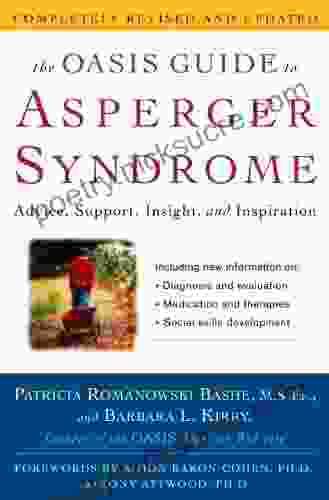
 Beau Carter
Beau CarterThe Oasis Guide to Asperger Syndrome
What is Asperger Syndrome? Asperger...
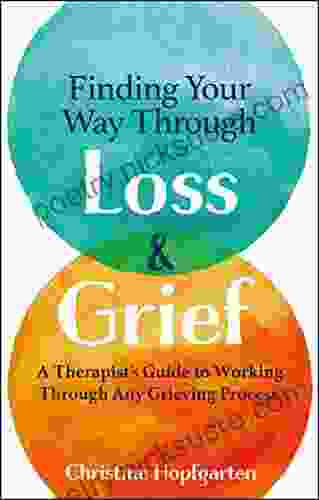
 Chadwick Powell
Chadwick PowellFinding Your Way Through Loss Grief: A Therapist S Guide...
Grief is a natural human emotion that we...
4.2 out of 5
| Language | : | English |
| File size | : | 34044 KB |
| Text-to-Speech | : | Enabled |
| Screen Reader | : | Supported |
| Enhanced typesetting | : | Enabled |
| Word Wise | : | Enabled |
| Print length | : | 294 pages |


